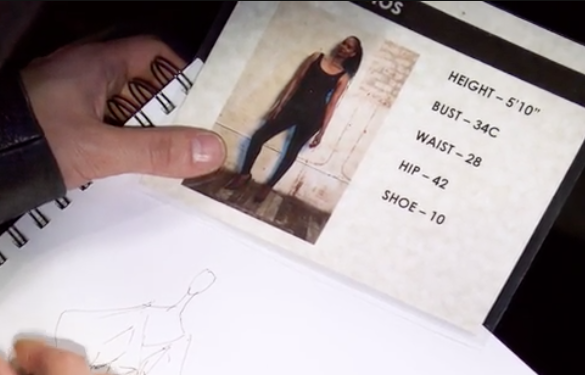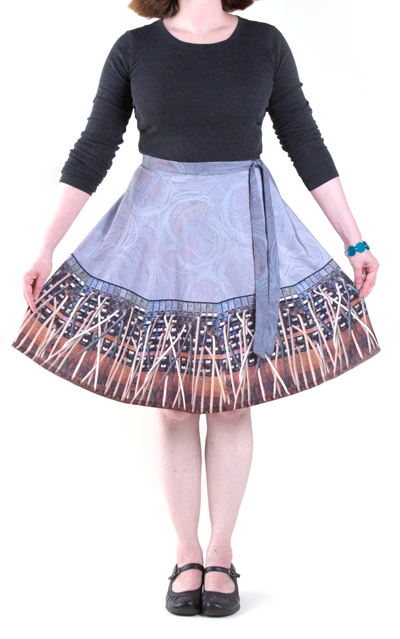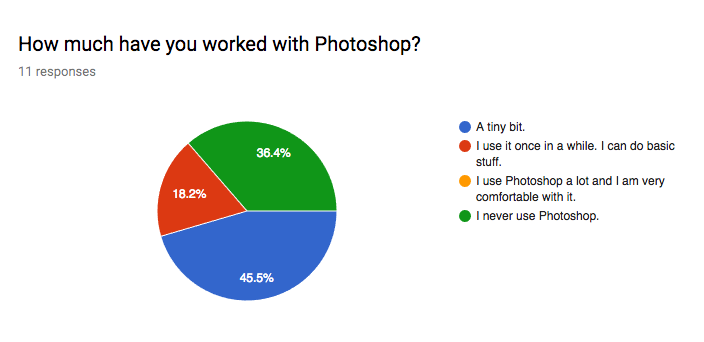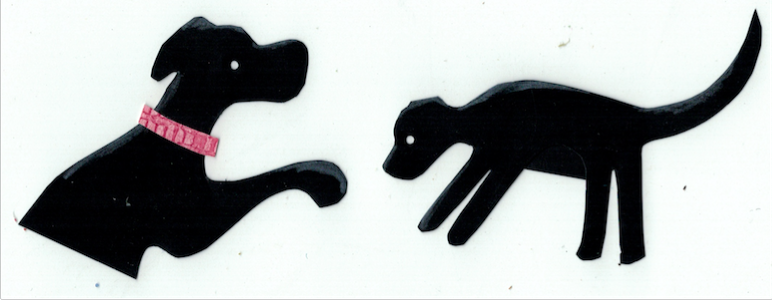We’ve been watching the most recent season of Project Runway. I love the show and I think Tim Gunn is completely brilliant. One of the new things this season is that the designers have to work with “real” sized models. Not just size 0, but ladies with some curves, which is awesome. I usually yell at the screen when I see the designers doing things with dye while not wearing gloves (a huge pet peeve), but this season I find myself yelling at the screen because they are complaining about having to design for “large” or “curvy” or “plus sized” girls. Or when they say that they have never designed for bigger than a size 0.
 Because you know what? They showed a couple of those cards with the models’ measurements and I grabbed a screen shot. One of those “bigger” girls that the designers were having a fit about: her measurements are basically the same as mine. (Except for the height. I am only 5’4″.) I sew clothing and I sew clothing a lot for myself, so I know my measurements and when I saw this card and heard them calling her a “big girl” I was a little bit… annoyed? disgusted? angry? offended? I am not sure. Either it’s “Woohoo, I am built like a model!” or “When did I suddenly become plus sized?” I am a short curvy size 6.
Because you know what? They showed a couple of those cards with the models’ measurements and I grabbed a screen shot. One of those “bigger” girls that the designers were having a fit about: her measurements are basically the same as mine. (Except for the height. I am only 5’4″.) I sew clothing and I sew clothing a lot for myself, so I know my measurements and when I saw this card and heard them calling her a “big girl” I was a little bit… annoyed? disgusted? angry? offended? I am not sure. Either it’s “Woohoo, I am built like a model!” or “When did I suddenly become plus sized?” I am a short curvy size 6.
 I spent the weekend doing a photoshoot of a bunch of my work. I have some exhibitions I want to enter and some work that I hadn’t had a chance to photograph yet and so I set up the dress forms and started shooting. That is my super glam set up in the basement. I do a lot of photos on dress forms because I like how they give the garment shape but basically the form melts into the background. They let the garments be the star of the shot and that’s really important to me. I rarely shoot on people because I think it’s distracting. Your brain is hardwired to look at faces and so that’s the first thing you look at, not my art.
I spent the weekend doing a photoshoot of a bunch of my work. I have some exhibitions I want to enter and some work that I hadn’t had a chance to photograph yet and so I set up the dress forms and started shooting. That is my super glam set up in the basement. I do a lot of photos on dress forms because I like how they give the garment shape but basically the form melts into the background. They let the garments be the star of the shot and that’s really important to me. I rarely shoot on people because I think it’s distracting. Your brain is hardwired to look at faces and so that’s the first thing you look at, not my art.
 But I had some more pieces, these wrap skirts specifically, that needed to be on a person. So that’s me getting to be the model. My husband shoots the photos when I am modeling. He’s a good guy. It’s exhausting (as you can see from our last dorky shot of the day), but I have several reasons that I didn’t want to hire a model to do it for me. There is the financial reality that if I hired a model, I would have to add significantly to the costs of these garments in order to cover that cost of finding, scheduling, and shooting with someone else. And I am not implying that my time is free, just that I can add those hours into the rest of the time I am paying myself for making/designing these and that makes a lot more sense.
But I had some more pieces, these wrap skirts specifically, that needed to be on a person. So that’s me getting to be the model. My husband shoots the photos when I am modeling. He’s a good guy. It’s exhausting (as you can see from our last dorky shot of the day), but I have several reasons that I didn’t want to hire a model to do it for me. There is the financial reality that if I hired a model, I would have to add significantly to the costs of these garments in order to cover that cost of finding, scheduling, and shooting with someone else. And I am not implying that my time is free, just that I can add those hours into the rest of the time I am paying myself for making/designing these and that makes a lot more sense.
So I have now spent several hours editing these photos to get them ready for various things. Adjusting the light, erasing the shoe scuffs on the paper, cropping, straightening and so on. And scrutinizing my body. (Do I have any volunteers who want to do that for a couple of hours? I didn’t think so.)
These wrap skirts are headed to my Etsy shop. I made a whole line of them (and some dresses which I haven’t photographed yet) for a couple of shows last year and I am finally getting an online shop put together that is all of my clothing and accessory pieces. I love these skirts. I love to wear them, I love how they move, I love how the fit is flexible so that you can make it fit whatever size you are today and be comfortable. I wear mine all the time and they fit my style. The rest of the pieces (mostly scarves) I have in the Etsy shop are on dress forms and they aren’t getting a lot of attention, so I thought maybe I needed the skirts to be on a person instead, to show the way they fit on someone with curves and bumps and a real figure. Because my dress forms are anything but real.

This is supposedly a size 4 dress form, but she is wearing a padded bra, two layers of bubble wrap around the waist, two petticoats and I still have a pleat pinned in the back to make this dress (which fits me) look like it fits on this dress form. For the last exhibition I did, I brought a whole roll of quilt batting to pad out my dress forms for more realistic figures because I don’t sew “sample” size garments. I make things that fit me. These dress forms with the arms only come in a nominal size 4. Coats and other things with sleeves look so much better on something with arms, so padding it out is the compromise for me.
There’s all kinds of marketing wisdom that says that your clothing has to be on a person to sell it online. It’s about selling the lifestyle as much or more than the item. People want to visualize themselves and they need that visual clue to make that happen. So I wanted to photograph those skirts on a person and see if that makes a difference to the reaction and attention that these get online in my Etsy shop. And I thought it was important that it was a real person and not a “model” figure.
Because despite the fact that I LOVE these skirts, I am really on the fence about whether I am going to continue making these at all. In person, they draw people in. I design very rich, complex surface patterns and these fabrics beg you to touch them and look at them up close. You can hold them up to you and that visualizing-yourself-wearing-it step is so much easier. Even if you aren’t a skirt-wearing kind of person. But what I have learned is that when I sell them in person, I spend the entire day having the same conversation.
That conversation is about personal body image issues.
I love this so much, but I can’t wear skirts because they make me look thick.
This is so great, but it hits the fat part of my calves and so I never wear skirts.
I wish I could wear this but I have no waist and so it would just make me look cut in half.
At the end of the day, I have heard about the insecurity, the perceived flaw, the thing that everyone feels that is wrong with themselves from all of these lovely women that I am meeting for the very first time at this art show. I might not even know their names, but I know that they think they have fat calves. Because they want to say something nice and tell me why they love this piece of fabric they have in their hands, but they don’t want to buy it. So they blame that on the easiest thing to blame. Themselves.
And it’s kind of heartbreaking. I don’t want to know what makes you feel insecure or unattractive.
The thing is, I know that only a small number of people that walk through my display are even going to be interested in buying something from me. Every artist knows this. Style is very personal; you have colors and patterns that you are drawn to and that make you feel good. I totally get that. I can’t wear red or animal prints. They bother me. I love to wear skirts because I think they are comfortable. But that’s not true for everybody. I LOVE to talk about my work and how it’s made but I don’t take it personally if it’s not your thing, because that thing that “clicks” and makes it your style is something different for everyone. Clothing is even more personal because it is art that is displayed on your person, not just on your wall. I don’t think people are compelled to explain to a photographer or painter that “I love this painting so much, but I think it will make my couch look frumpy.” But I don’t know. (If you are a painter, please chime in, I am super curious.)
And I get it. I just spent a few hours zoomed in on these photos looking for lint and weird shadows and noticing the wrinkles at my waist and hearing that stupid inner critic voice say “that waistline isn’t as trim as it was when you were 20” and “that skirt would look more balanced if your torso wasn’t so short.” That inner critic voice is always there telling you to be more something or less something. I am pretty comfortable in my skin, but that doesn’t mean I’m not hearing it. All the time.

I am also limited by the materials a little with these skirts. This design is made from a single piece of fabric that is shaped like a large C. Based on the width of the fabric, I can only make these fit up to about a size 14 before the wrap is not wrapping enough to prevent you from showing off your knickers. So I am limited by the width of my materials and this design. And I could certainly print more fabric and piece it together to make it wider. But then there is a seam, which makes it hang and drape differently, and it takes longer to sew and I have to buy double the fabric. Which means that a size 14 has one cost and a size 16 is drastically more. Which is completely unfair. Ugh. (Or I raise the price so they are all the same and that makes them only affordable to people who have a lot more disposable income than I do. Also ugh.) Between explaining that I don’t have any larger sizes (which makes me sounds like a whiny Project Runway designer) and hearing about fat calves, it makes these a little less fun for me. And so they’ve been hanging in a closet, waiting for me to figure it out.
So the last thing I am doing with this post is fishing for someone to tell me that I am skinny and not plus sized. That’s not my point. I am writing this post because it is something that needs more thinking about.
How can I change the conversation? What can I do that encourages a more body positive conversation but that still lets me make wearable art and love doing it? Scarves are a practical solution. They don’t have a “fit”, they show off my patterns beautifully and lots of people love them. But lots of people make them too and everyone I know has a lot of scarves already.
I don’t know the answer, but I am very interested in the conversation. What do you think?




















